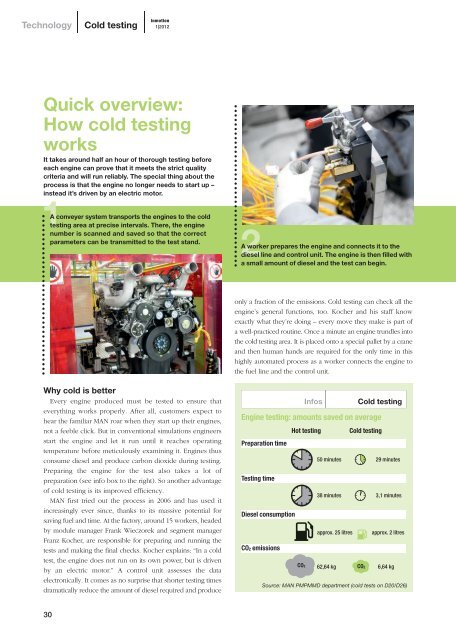You also want an ePaper? Increase the reach of your titles
YUMPU automatically turns print PDFs into web optimized ePapers that Google loves.
Technology Cold testing<br />
Why cold is better<br />
Every engine produced must be tested to ensure that<br />
everything works properly. After all, customers expect to<br />
hear <strong>the</strong> familiar <strong>MAN</strong> roar when <strong>the</strong>y start up <strong>the</strong>ir engines,<br />
not a feeble click. But in conventional simulations engineers<br />
start <strong>the</strong> engine and let it run until it reaches operating<br />
temperature before meticulously examining it. Engines thus<br />
consume diesel and produce carbon dioxide during testing.<br />
Preparing <strong>the</strong> engine for <strong>the</strong> test also takes a lot of<br />
preparation (see info box to <strong>the</strong> right). So ano<strong>the</strong>r advantage<br />
of cold testing is its improved efficiency.<br />
<strong>MAN</strong> first tried out <strong>the</strong> process in 2006 and has used it<br />
increasingly ever since, thanks to its massive potential for<br />
saving fuel and time. At <strong>the</strong> factory, around 15 workers, headed<br />
by module manager Frank Wieczorek and segment manager<br />
Franz Kocher, are responsible for preparing and running <strong>the</strong><br />
tests and making <strong>the</strong> final checks. Kocher explains: “<strong>In</strong> a cold<br />
test, <strong>the</strong> engine does not run on its own power, but is driven<br />
by an electric motor.” A control unit assesses <strong>the</strong> data<br />
electronically. It comes as no surprise that shorter testing times<br />
dramatically reduce <strong>the</strong> amount of diesel required and produce<br />
30<br />
<strong>inmotion</strong><br />
1|2012<br />
Quick overview:<br />
How cold testing<br />
works<br />
It takes around half an hour of thorough testing before<br />
each engine can prove that it meets <strong>the</strong> strict quality<br />
criteria and will run reliably. The special thing about <strong>the</strong><br />
process is that <strong>the</strong> engine no longer needs to start up –<br />
instead it’s driven by an electric motor.<br />
1<br />
A conveyer system transports <strong>the</strong> engines to <strong>the</strong> cold<br />
testing area at precise intervals. There, <strong>the</strong> engine<br />
number is scanned and saved so that <strong>the</strong> correct<br />
parameters can be transmitted to <strong>the</strong> test stand.<br />
2A worker prepares <strong>the</strong> engine and connects it to <strong>the</strong><br />
diesel line and control unit. The engine is <strong>the</strong>n filled with<br />
a small amount of diesel and <strong>the</strong> test can begin.<br />
only a fraction of <strong>the</strong> emissions. Cold testing can check all <strong>the</strong><br />
engine’s general functions, too. Kocher and his staff know<br />
exactly what <strong>the</strong>y’re doing – every move <strong>the</strong>y make is part of<br />
a well-practiced routine. Once a minute an engine trundles into<br />
<strong>the</strong> cold testing area. It is placed onto a special pallet by a crane<br />
and <strong>the</strong>n human hands are required for <strong>the</strong> only time in this<br />
highly automated process as a worker connects <strong>the</strong> engine to<br />
<strong>the</strong> fuel line and <strong>the</strong> control unit.<br />
Preparation time<br />
<strong>In</strong>fos Cold testing<br />
Engine testing: amounts saved on average<br />
Testing time<br />
Diesel consumption<br />
CO2 emissions<br />
Hot testing Cold testing<br />
50 minutes 29 minutes<br />
38 minutes 3,1 minutes<br />
approx. 25 litres approx. 2 litres<br />
CO2 62,64 kg CO2<br />
6,64 kg<br />
Source: <strong>MAN</strong> PMPMMD department (cold tests on D20/D26)










